8 Lovable Villains from Film and Television
Introduction
While there has never been a shortage of great heroes in film or television over
the years, there have been few truly great villains – one’s that are just as
engaging and intricate as their heroic counterparts. Certainly, there have been
a number of great (even if somewhat one-dimensional) straight up villains such
as Darth Vader from ‘Star Wars’ – ‘IV: A New Hope’ (1977), ‘V: The Empire
Strikes Back’ (1980), ‘VI: Return of the Jedi’ (1983), ‘III: Revenge of the Sith’
(2005) – Mr. Burns from ‘The Simpsons’ (1989 – present) and Hannibal Lecter from
‘Silence of the Lambs’ (1991). These are villains that people just love to hate,
though. There is another class of villain and one that could arguably be
significantly more interesting, engaging and entertaining – one that people
just, well, love.
8) Dan Castellaneta,
the Robot Devil (‘Futurama’)
For a show that featured numerous and intricate supporting characters that ranged
in forms from human, to robot, to alien, arguably the best supporting character
throughout the run of ‘Futurama’ (1999 – 2003, 2008 – present) in the series is
the Robot Devil.
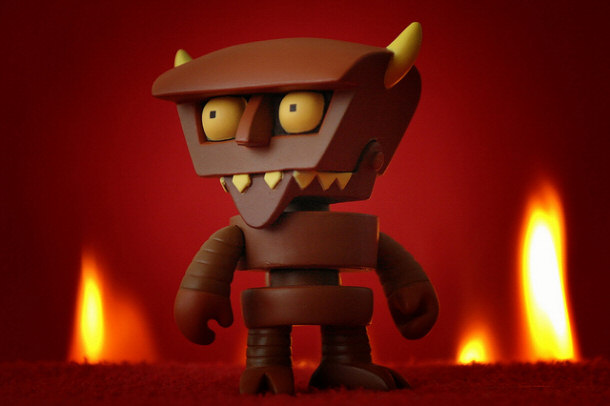
The character is voiced by Dan Castellaneta, who is best known as the voice
of Homer from ‘The Simpsons’. The character first appears in the episode ‘Hell
in Other Robots’ from the first season of the series when Bender – the
alcoholic, womanizing, kleptomaniacal robot – converts to the religion,
Robotology, which forbids all the vices that Bender has always loved to indulge
in. When Bender is unable to adhere to the strict guidelines of the faith, he is
abducted and taken to a real-life, functioning Hell. Enter the Robot Devil.
Fittingly, for a show that is set 1000 years in the future but also pays
homage to the early years of motion pictures (each opening title sequence
features footage from various classic animations) the Robot Devil was the
epitome of futuristic technology mixed with the olden-day style of vaudevillian
entertainment. The Robot Devil’s immediate likability was certainly helped by
the fact that no sooner had he made his debut in the series than he breaks into
an elaborate, jazz-inspired song and dance about sinning and the subsequent
suffering, which features a cameo of the rap group, The Beastie Boys.
The character was so lovable that when those behind the series heard that
there was a strong likelihood that the series would not be renewed after the
fourth season, they opted to conclude the series with an episode that revolved
heavily around the Robot Devil, ‘The Devil’s Hands are Idol Playthings’, in
which the lead character Fry switched hands with the Robot Devil. Years later,
the series was renewed, with the Robot Devil making numerous other special
appearances.
7)
Alan Cumming, the Devil (God, the Devil and Bob)
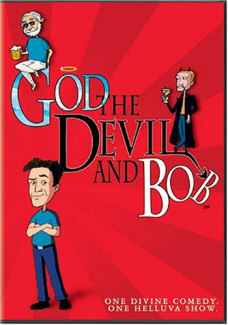 ‘God, the Devil and Bob ‘God, the Devil and Bob ’ (2000) was a controversial animated series that
revolved around a man, Bob, an everyday guy whose daily moral decisions would
decide whether God should continue with humanity or destroy the whole thing,
after God and the Devil made a wager to see if humanity was worthwhile. The
series was so controversial that it was canceled after just four episodes due to
pressure from religious groups that objected to essentially nothing more than
just the premise of the series, given that the protests began before the show
had even aired. ’ (2000) was a controversial animated series that
revolved around a man, Bob, an everyday guy whose daily moral decisions would
decide whether God should continue with humanity or destroy the whole thing,
after God and the Devil made a wager to see if humanity was worthwhile. The
series was so controversial that it was canceled after just four episodes due to
pressure from religious groups that objected to essentially nothing more than
just the premise of the series, given that the protests began before the show
had even aired.
By today’s standards the show is tame. In fact, by the standards of 2000 it
was pretty tame, when one considers that ‘Bevis and Butthead’ (1993 – 1997,
2011), ‘South Park’ (1997 – present) and even the family-friendly and, more
importantly, advertiser-friendly ‘The Simpsons’ (1989 – present) were doing just
as edgy (if not edgier) stuff. Really, the controversy lay simply in the eyes of
religious zealots who were offended by an idea of a God that deviated from their
own. That is, a God (voiced by veteran actor, James Garner) who was depicted as
a laid-back, sunglasses-wearing hippy-like figure, who enjoyed a beer.
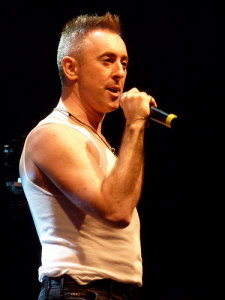 Oddly, the least controversial aspect of the series was that Satan (voiced by
Alan Cummings) was actually quite likeable. While he was clearly evil, his
depiction deviated greatly from the classical and conventional representations
that are generally associated with the Devil. Cummings brought an unusual
likeability to the role – giving the Devil a cultured and sophisticated air,
juxtaposed with an often petulant and whiny side. This, coupled with the
character still being inherently evil, made for an unusual and oddly engaging
combination. Oddly, the least controversial aspect of the series was that Satan (voiced by
Alan Cummings) was actually quite likeable. While he was clearly evil, his
depiction deviated greatly from the classical and conventional representations
that are generally associated with the Devil. Cummings brought an unusual
likeability to the role – giving the Devil a cultured and sophisticated air,
juxtaposed with an often petulant and whiny side. This, coupled with the
character still being inherently evil, made for an unusual and oddly engaging
combination.
It’s a tremendous shame that the show is known pretty much exclusively for
the surrounding controversy, and thus Cummings' performance (and all the other
great performances in the show, such as Garner’s and French Stewart’s
performance as Bob) goes largely unnoticed by most, though greatly appreciated
by the few who saw and enjoyed the series – while it lasted.
6)
Jack Lemmon, Professor Fate (‘The Great Race’)
As one of the biggest A-lister movie stars of the time, Tony Curtis,
was supposed to be the star of the movie, ‘The Great Race ’ (1965) about an
elaborate car race that starts in New York City and finishes in Paris. However,
while Curtis was good in the role of the hero and even Natalie Wood put in a
strong performance as Curtis’ love interest, Jack Lemmon was the by far the true
star of the film. ’ (1965) about an
elaborate car race that starts in New York City and finishes in Paris. However,
while Curtis was good in the role of the hero and even Natalie Wood put in a
strong performance as Curtis’ love interest, Jack Lemmon was the by far the true
star of the film.
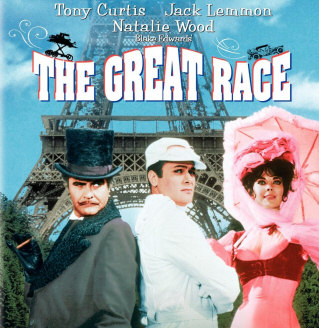 Usually cast in the supporting role of a comic duo, Lemmon deviated
dramatically from the clichés and stereotypes of his previous comedic roles to
portray the ruthless, maniacal villain, Professor Fate, to reveal a profoundly
intricate comedic genius that lay beneath the public’s fairly one-dimensional
perception of the actor. Usually cast in the supporting role of a comic duo, Lemmon deviated
dramatically from the clichés and stereotypes of his previous comedic roles to
portray the ruthless, maniacal villain, Professor Fate, to reveal a profoundly
intricate comedic genius that lay beneath the public’s fairly one-dimensional
perception of the actor.
Almost physically and characteristically unrecognizable in the role, Lemmon
embraced the character completely and remarkably found a way of depicting what
was essentially a caricature in a realistic, if somewhat camp, manner.
In regards to Lemmon’s legacy, the role and his performance as Fate would be
overshadowed by the multi Oscar Award winner’s many other great performances.
Still, Lemmon’s performance was an achievement all its own. Even in a film that
was essentially an homage to earlier vaudevillian-inspired slapstick comedies,
Lemmon still managed to find depth in a potentially one dimensional character
that was too lovable for the audience to even love to hate.
5)
Michael McKean, Morris Fletcher (The X-files/The Lone Gunmen’)
‘The X-Files’ (1993 – 2002) was a phenomenon in the 1990s. So much so, that the
effect of the groundbreaking series can still be felt today, as it was one of
the first series to push the boundaries of what a television series is supposed
to be. For the first time in television, the quality of direction,
cinematography and writing for a television series were of a movie caliber in a
time when television production was seen as an art form secondary to film. The
humor of the series, which was just as crucial and impactful as anything else
the series had to offer, wasn’t quite so appreciated.
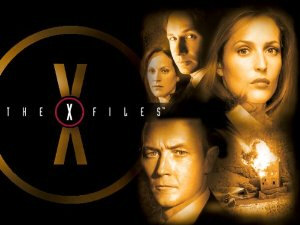 One of the many underrated humorous episodes of ‘The X-Files’ is the double
episode, ‘Dreamland One of the many underrated humorous episodes of ‘The X-Files’ is the double
episode, ‘Dreamland ’ from the sixth season. In the episode, Michael McKean plays
Morris Fletcher, a Man in Black – a government secret service agent responsible
for keeping the general public from discovering the covert relationship between
extra terrestrials and the American government. In the episode, Fletcher ends up
switching lives with one of the lead characters, Fox Mulder (played by David
Duchovny). The character would later appear in both the ‘The X-Files’ and the
short-lived spin-off series ‘The Lone Gunmen’ (2001). ’ from the sixth season. In the episode, Michael McKean plays
Morris Fletcher, a Man in Black – a government secret service agent responsible
for keeping the general public from discovering the covert relationship between
extra terrestrials and the American government. In the episode, Fletcher ends up
switching lives with one of the lead characters, Fox Mulder (played by David
Duchovny). The character would later appear in both the ‘The X-Files’ and the
short-lived spin-off series ‘The Lone Gunmen’ (2001).
The character was never a good guy but he certainly was a character.
Interestingly, the character is essentially a jerk on the surface, though
somewhat sentimental and completely lovable – despite still being kind of evil
at heart. Such an awful, intricate and strangely poignant character could
perhaps only have been played by Michael McKean.
McKean is probably best known for his iconic performance in ‘This is Spinal
Tap’ (1984) about a bunch of hapless, egomaniacal, pretentious rock stars. While
the role and McKean’s performance in ‘The X-Files’ won’t ever overshadow his
performance in ‘This is Spinal Tap’, his depiction of Morris Fletcher certainly
doesn’t pale in comparison either.
4)
Billy Zane, the Collector (‘Tales from the Crypt: Demon Knight’)
Despite the high profile of the films in which Billy Zane first appeared –
namely, ‘Back to the Future’ (1985) and ‘Back to the Future Part II’ (1989) –
his initial cinematic roles went mostly unnoticed, when he appeared (briefly) as
one of the minions of the arch villain, Biff.
It was only when Zane transitioned from playing the henchman to an arch
villain that he carved out a niche for himself. It was the film ‘Dead Calm’
(1989), in which he played a man found adrift in the ocean, only to turn on his
saviors, that Zane showed his knack for villains.
He would later go on to display a great talent for quirky, lovable villains.
‘Tales from the Crypt: Demon Knight’ (1995) would arguably be his best
performance in just such a role. Zane depicted a demon, known as the Collector,
on a mission to capture a key with which he could throw the world into darkness
and disarray. Not only looking the part with his broad, evil, Joker-like smile,
but his appearance coupled with the affable, though clearly psychopathic
personality fit perfectly for the character, whose strongest weapon was his
charm and charisma with which he used to seduce each of his victims with
offerings of their wildest desires.
Zane would later be cast as a villain in James Cameron’s ‘Titanic’ (1997),
depicting a mildly charismatic, though completely unlikable character. This is
the role for which he is perhaps best known. His performance in ‘Demon Knight’
is by far his best performance. This fact is made bittersweet when one considers
that it’s his role in ‘Titanic’ for which he is best known, due entirely to the
high profile of the film in comparison to ‘Demon Knight’.
3)
Peter Sellers, Dr. Strangelove (‘Dr. Strangelove or: How I Learned to Stop
Worrying and Love the Bomb’)
Based very, very loosely on the book
‘Red Alert ’ (1958) by Peter
Bryant, both
the movie
‘Dr. Strangelove or: How I Learned to Stop Worrying and Love the Bomb ’ (1958) by Peter
Bryant, both
the movie
‘Dr. Strangelove or: How I Learned to Stop Worrying and Love the Bomb ’
(1964) and the titular character, Dr. Strangelove, portrayed by Peter Sellers,
are cinematic classics. While the original planned adaptation had remained
relatively true to the source material, director Stanley Kubrick was forced to
deviate from the book dramatically when he discovered that a similar movie from
another director was already under production. ’
(1964) and the titular character, Dr. Strangelove, portrayed by Peter Sellers,
are cinematic classics. While the original planned adaptation had remained
relatively true to the source material, director Stanley Kubrick was forced to
deviate from the book dramatically when he discovered that a similar movie from
another director was already under production.
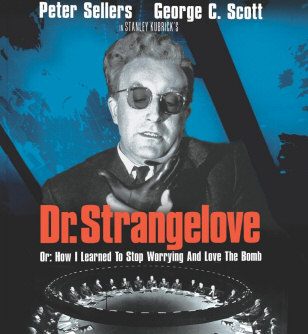 Never eager to follow in the footsteps of another film maker, Kubrick had the
script heavily re-written, turning what had been a fairly serious drama about
Russia and America launching missiles against one another, into the comedic,
social satire that lampooned and criticized government policy, while questioning
both the sanity of government officials and that of humanity itself. Never eager to follow in the footsteps of another film maker, Kubrick had the
script heavily re-written, turning what had been a fairly serious drama about
Russia and America launching missiles against one another, into the comedic,
social satire that lampooned and criticized government policy, while questioning
both the sanity of government officials and that of humanity itself.
While Kubrick’s efforts went greatly unappreciated by the author of the book,
movie goers, film critics and the general arts community embraced the film. This
was not just for the cinematic masterpiece that resulted, but also and perhaps
largely because of the performances of Sellers.
Despite playing a number of characters throughout the film – including Group
Captain Lionel Mandrake and President Merkin Muffley – it was Dr. Strangelove,
the eccentric, amoral alien-hand-syndrome suffering scientific genius that
deservedly got the attention and praise from audiences and critics alike, with
the character epitomizing the absurdity that lies at the core of human nature.
2)
James Gandolfini, Tony Soprano (‘The Soporanos’)
‘The Sopranos ’ (1999 – 2007) was a fascinating television series for many
intricate reasons. Never before in the history of film or television had the mob
and in particularly a mob boss been portrayed in such a realistic light.
Specifically, a light that emphasized, amongst other things, the good, the bad
and the truly gruesome, behind the lives and actions of those involved in
organized crime. Perhaps the most significant other aspect of the series is that
the show highlighted the depth of the heart and humor of such a life and the
characters involved. ’ (1999 – 2007) was a fascinating television series for many
intricate reasons. Never before in the history of film or television had the mob
and in particularly a mob boss been portrayed in such a realistic light.
Specifically, a light that emphasized, amongst other things, the good, the bad
and the truly gruesome, behind the lives and actions of those involved in
organized crime. Perhaps the most significant other aspect of the series is that
the show highlighted the depth of the heart and humor of such a life and the
characters involved.
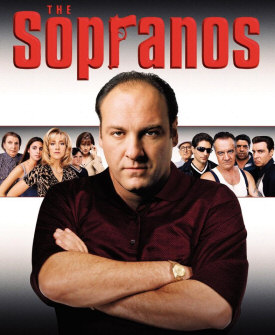 While the premise of the television series, ‘The Sopranos’ – that is, a mob
boss who starts going to therapy – had already been done before in the films
‘Analyze This’ (1999) and the sequel ‘Analyze That’ (2002), the ‘The Sopranos’
took both the premise and television as a whole to a totally new level. Rather
than play on the inherent oddity and humor of the scenario, the series looked
deeper into the character of the mob boss in question, Tony Soprano, to look at
the heart, soul and evil of such a character in more detail than had ever been
done before. While the premise of the television series, ‘The Sopranos’ – that is, a mob
boss who starts going to therapy – had already been done before in the films
‘Analyze This’ (1999) and the sequel ‘Analyze That’ (2002), the ‘The Sopranos’
took both the premise and television as a whole to a totally new level. Rather
than play on the inherent oddity and humor of the scenario, the series looked
deeper into the character of the mob boss in question, Tony Soprano, to look at
the heart, soul and evil of such a character in more detail than had ever been
done before.
The result was one of the greatest television series of all time – and one of
the greatest performances of all time. Many factors and very talented
individuals came together to produced such a great television series, but
arguably the key ingredient was both the character of Tony Soprano and the
performance of James Gandolfini in the role.
Prior to ‘The Sopranos’ Gandolfini had made a name for himself playing a hit
man in both ‘Get Shorty’ (1995) and ‘True Romance’ (1993) with the latter being
just as intense, dark and violent as ‘The Sopranos’. It seemed almost inevitable
that he would be cast in the role of a mob boss at some point in his career, as
it’s easy for actors to get typecast as simply mob figures (many of the regular
and guest actors who would appear on the series were just such actors whose
careers read like a mafia movie encyclopedia).
Gandolfini was different, though. The role called for Gandolfini to humanize
the figure, given that, at the core of the series, was the exploration of the
man behind the fairly clichéd mob boss veneer – the murderer, drug-dealer,
philanderer – and look at the impact and consequences those factors have on
those around such a character, particularly on his family.
Remarkably, Gandolfini found the depth beneath the mobster clichés. Like a
true sociopath, Soprano’s true evil was masked with a very commonplace exterior.
Throughout the series, Soprano was often seen wearing shorts, flip-flops and an
old shirt. Furthermore, he lived in a very nice house, but nothing like the
opulence of other mob bosses seen in other mafia films and television series.
Soprano’s down-to-earth and affable personality was as unexpected as his
appearance and surrounding.
One could argue that Gandolfini’s depiction of a mobster is perhaps the most
realistic and even the best onscreen performance ever seen – even when compared
to other such iconic cinematic mob figures, such as Al Pacino’s performances as
Michael Corleone in the ‘Godfather’ trilogy – ‘The Godfather’ (1972), ‘The
Godfather Part II’ (1974) and ‘The Godfather Part III’ (1990) – or Tony Montana
in ‘Scarface’ (1983) or Robert De Niro as Jimmy Conway in ‘Goodfellas’ (1990).
What is undeniable is that Gandolfini managed to shatter the stereotype, delving
through the clichés of the archetype, to find the intricate, convoluted core of
a truly unique character.
1)
Harry Groener, Richard Wilkins III ‘Buffy the Vampire Slayer’
Arguably the most lovable villain of all time would have to be the Mayor of
Sunnydale, Richard Wilkins III, from the TV series ‘Buffy the Vampire Slayer ’
(1997 – 2003). ’
(1997 – 2003).
With an uncanny knack for taking something either clichéd or downright absurd
and making something amazing out of it, the show’s creator, Joss Whedon, somehow
managed to create one of the most ironic, sarcastic and incredibly intricate
characters when he created Wilkins.
The thing that made him so remarkable was a simple ironic and sarcastic
combination of the fact that the character was clearly evil but nevertheless
super polite – the result of which was comedic gold.
While the premise alone was genius, the character could have fallen flat had
it not been for an equally brilliant casting call, when Harry Groener was cast
to portray the character. Having previously (and, alas subsequently) portrayed
fairly one dimensional characters in a variety of television series and movies,
his performance on ‘Buffy the Vampire Slayer’ highlight that he is clearly one
of the most underrated actors currently working in the industry.
His presence in the series only last a single season, but his impact is
profound. While the series would go on to create a number of elaborate, quirky
and lovable villains throughout the series’ run, none would come even remotely
close to matching Wilkins.
Mixing a respect and appreciation for basic human decency, the character also
possessed great satirical value as a parody of those in real-life who espouse a
respect for basic human decency – appreciating basic manners, unwritten social
code etc. – who then advocate the persecution of others that are different, be
it because of social class, race, religion etc.
Numerous elements colluded to make this character the epitome of a great
villain – one who embodies the most terrifying aspect of evil – that pure evil
has, not a grotesque visage, but rather a bright, shining friendly face. In this
case, a face that belongs to one of the most lovable, intricate and subversive
villain of all time.
Conclusion
The key to creating a great character, whether they’re a hero or a villain, is
diversity. Like us all, characters have to possess a multitude of character
traits – both good and bad. In all honesty, what sets a character apart and
defines them as either a good or a bad person simply comes down to numbers –
that is, a good or heroic character is defined by their good characteristic
outnumbering their bad and vice-versa for villainous characters.
With the key to a great character being intricacy, such intricacy arguably
works best with villains, because it’s generally unexpected – at least for the
audience. In reality, villains are more often than not likeable, despite their
inherent evil. Charm, wit and charisma are common personality traits amongst
many serial killers. These are often the things that enable them to commit their
acts of evil for years without discovery, because the facade they present to the
world is so dramatically contrary to their actions and true personality.
Beyond their acts of evil, it is their affable personality that is perhaps
the most disturbing aspect of a sociopath. This is the very same thing that
makes truly great villains intricate, interesting and terrifying in the most
human and uncomfortable way and (at least when it comes to seeing them in film
and television) eerily lovable.
Television
Top Lists:
15 Astonishing Ways Television Series Make You Sharper
Shorter Top Lists:
10 Actors Who Prove Smart People Make the Best Dumb Characters
8 Lovable Villains from Film and Television
Informational:
The Movie Wolf Creek is an Example of Great Script Analysis & Performance
|